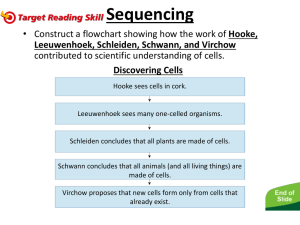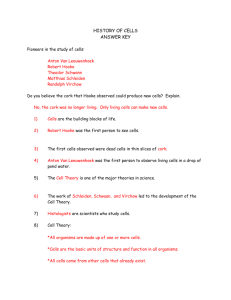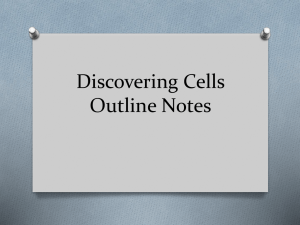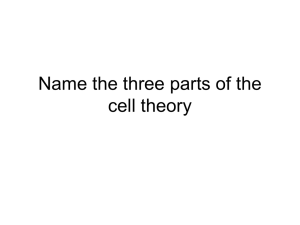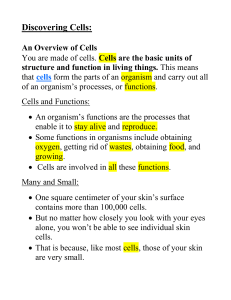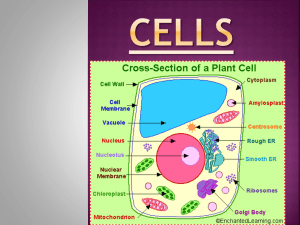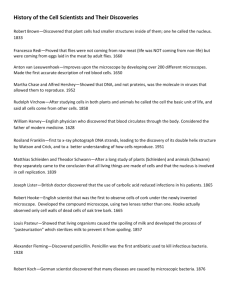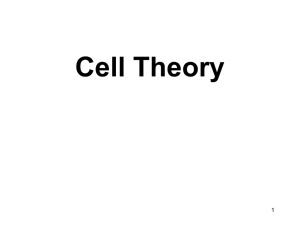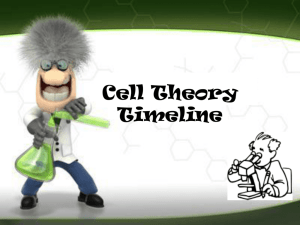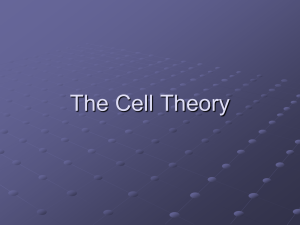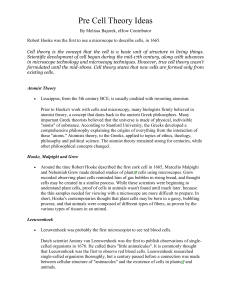The Cell Theory Timeline
advertisement
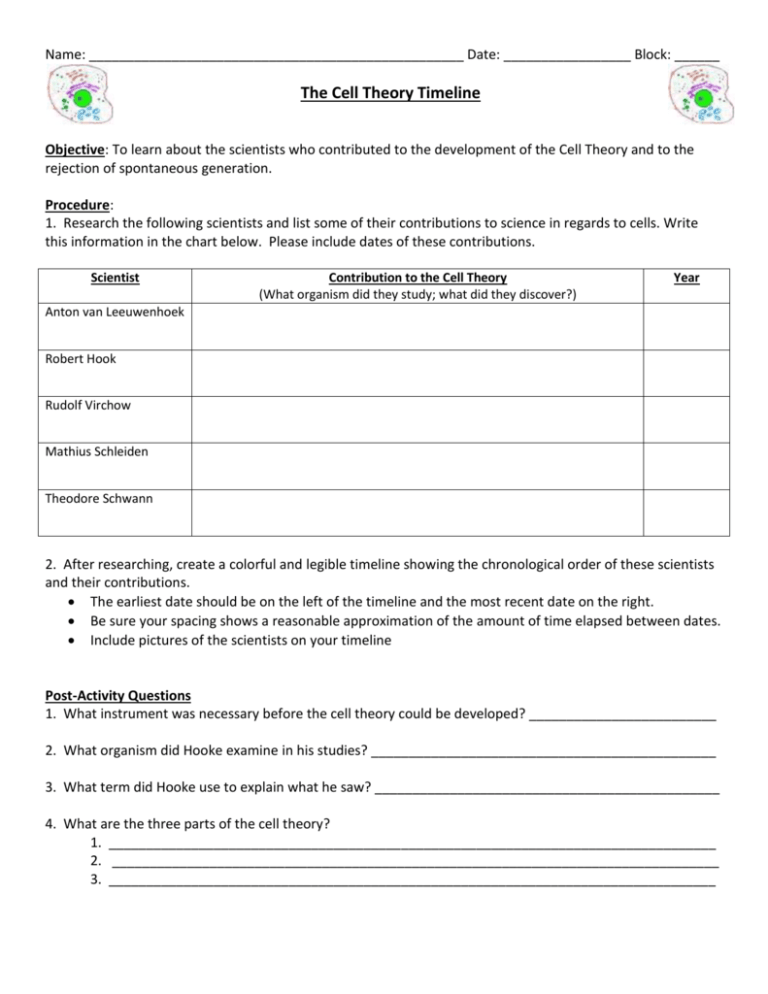
Name: __________________________________________________ Date: _________________ Block: ______ The Cell Theory Timeline Objective: To learn about the scientists who contributed to the development of the Cell Theory and to the rejection of spontaneous generation. Procedure: 1. Research the following scientists and list some of their contributions to science in regards to cells. Write this information in the chart below. Please include dates of these contributions. Scientist Contribution to the Cell Theory (What organism did they study; what did they discover?) Year Anton van Leeuwenhoek Robert Hook Rudolf Virchow Mathius Schleiden Theodore Schwann 2. After researching, create a colorful and legible timeline showing the chronological order of these scientists and their contributions. The earliest date should be on the left of the timeline and the most recent date on the right. Be sure your spacing shows a reasonable approximation of the amount of time elapsed between dates. Include pictures of the scientists on your timeline Post-Activity Questions 1. What instrument was necessary before the cell theory could be developed? _________________________ 2. What organism did Hooke examine in his studies? ______________________________________________ 3. What term did Hooke use to explain what he saw? ______________________________________________ 4. What are the three parts of the cell theory? 1. _________________________________________________________________________________ 2. _________________________________________________________________________________ 3. _________________________________________________________________________________ Anton van Leeuwenhoek Matthius Schleiden Rudolf Virchow Robert Hooke Theodor Schwann Discovery of Cells and the Development of Cell Theory The study of cells started about 350 years ago. Before that time cells escaped notice because of their small size. With the invention of the microscope and its subsequent improvement, cells became visible and many new discoveries were made about them. Even today the study of cells reveals more detail, and its secrets, which are in fact the secrets of life itself, are revealed with ever increasing clarity. Hooke was born on the Isle of Wight and educated at the University of Oxford. He served as assistant to the English physicist Robert Boyle and assisted him in the construction of the air pump. In 1662 Hooke was appointed curator of experiments of the Royal Society and served in this position until his death. He was elected a fellow of the Royal Society in 1663 and was appointed Gresham Professor of Geometry at Oxford in 1665. After the Great Fire of London in 1666, he was appointed surveyor of London, and he designed many buildings, including Montague House and Dethlehem Hospital. In 1665, Robert Hooke described a honeycomb-like appearance of cork bark using his primitive compound microscope. Robert Hooke used the term “cells” to describe cell walls in plants. Of course, he saw only cell walls because cork cells are dead. He drew the cells he saw and also coined the word cell. Hooke published his findings in his famous work, Micrographia. Hooke's Microscope Hooke's drawing of Cork Cells Anton van Leeuwenhoek, born Oct. 24, 1632, was a Dutch biologist and microscopist. He became interested in science when, as a Dutch businessman, he began grinding lenses and building simple microscopes as a hobby. Each microscope consisted of a flat brass or copper plate in which a small, single glass lens was mounted. The lens was held up to the eye, and the object to be studied was placed on the head of a movable pin just on the other side of the lens. Leeuwenhoek made over 400 microscopes, many of which still exist. The most powerful of these instruments can magnify objects about 275 times. Although future microscopes were to contain more than one lens (compound microscopes), Leeuwenhock's single lens was ground to such perfection that he was able to make great advances and to draw attention to his field. Leeuwenhoek was the first person to observe single-celled animals (protozoa) with a microscope in 1674. He described them in a letter to the Royal Society, which published his detailed pictures in 1683. Leeuwenhoek was also the first person, using a microscope, to observe clearly and to describe red blood cells in humans and other animals, as well as sperm cells. In addition, he studied the structure of plants, the compound eyes of insects, and the life cycles of fleas, aphids, and ants. Matthias Schleiden was born in Hamburg and educated in law at Heidelberg, Schleiden left law practice to study botany, which he then taught at the University of Jena from 1839 to 1862. In 1838, Schleiden investigated plants microscopically and conceived that plants were made up of recognizable units, or cells. Plant growth, he stated in 1837, came about through the production of new cells. A year after Schleiden published his cell theory on plants, his friend Schwann extended it to animals, thereby bringing botany and zoology together under one unifying theory. Schwann, Theodor (1810-82), German physiologist, was born in Neuss and educated at the universities of Bonn, Warzburg, and Berlin. He was (1838-48) professor of anatomy at the University of Leuven in Belgium. In 1839, Theodor Schwann reached the same conclusion as Schleiden about animal tissue being composed of cells, ending speculations that plants and animals were fundamentally different in structure. He pulled existing observations together into theory that stated: 1. Cells are organisms and all organisms consist of one or more cells. 2. The cell is the basic unit of structure for all organisms. This statement was the second generalization concerning cells and is the most important in the development of biology. It became known as the cell theory. Virchow, Rudolf (1821-1902) was a German pathologist, archaeologist, and anthropologist, the founder of cellular pathology. Virchow was born in Swidwin, Poland, and educated at the University of Berlin. Virchow was the first to demonstrate that the cell theory applies to diseased tissue as well as to healthy tissue-that is, that diseased cells derive from the healthy cells of normal tissue. In 1855, Virchow was able to add a third part to the cell theory: all cells develop only from existing cells. He engaged also in extensive research in the fields of archaeology and anthropology, producing numerous writings, among them Crania Ethnica Americana (1892). Other publications include discussions of topical political and social questions. Virchow was influential in German politics and from 1880 to 1893 served as a Liberal in the German Reichstag, where he opposed the policies of the German chancellor Prince Otto von Bismarck. He was instrumental in the establishment of the Pathological Institute and Museum in Berlin.
